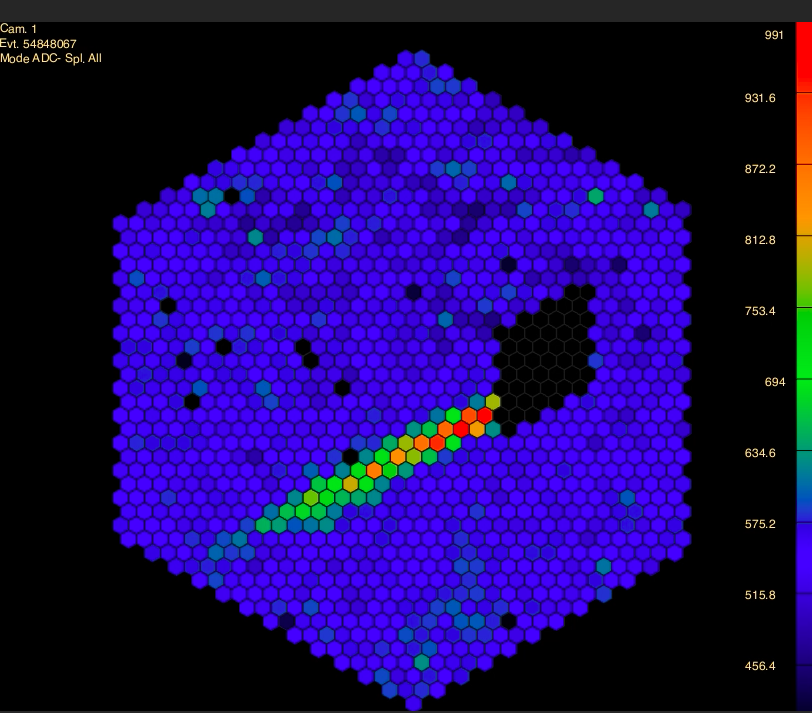
On Thursday, Aug. 31, 2017, a prototype telescope proposed for the Cherenkov Telescope Array (CTA), the SST-1M, recorded its first events while undergoing testing at the Institute of Nuclear Physics Polish Academy of Sciences (IFJ-PAN) in Krakow, Poland. The SST-1M is proposed as one of CTA’s Small-Sized Telescopes (SSTs), which will cover the high end of CTA’s energy range, between about 1 and 300 TeV (tera-electronvolts).
A crew in Krakow worked to install the camera on the telescope for 2 days (https://youtu.be/WJzN9poS-Bw). Other two days were required in order to make sure that the camera could be safely switched on due to very high humidity weather conditions (https://youtu.be/WJzN9poS-Bw).
On Aug. 31, at night, another crew in Geneva, Switzerland, sent the remote control commands to the telescope to start tracking with the camera two gamma-ray emitters (two black holes). Within seconds, the coordinates of the first source were set and the telescope slewed into the observation position, allowing the telescope to track the source and the data to flow. Even with the moonlight and lights from the city, more than 5 million events and 330 GB of data were acquired with the camera in less than 1.5 hours of operation! The images in the video below shows one of the beautiful events captured (http://www.isdc.unige.ch/%7Elyard/FirstLight/FirstLight_slowHD.mov).
“Additional tuning and hours of operation are needed before the SST-1M performance can be clearly assessed, but this is a major milestone for the project and its participants, who have worked hard through five years of design and laboratory testing to make this accomplishment a reality,” said Prof. T. Montaruli, project leader of the SST-1M.
The SST-1M project team includes 12 institutes from 5 countries (Czech Republic, Ireland, Poland, Switzerland and Ukraine). The SST-1M project team includes 12 institutes from 5 countries (Czech Republic, Ireland, Poland, Switzerland and Ukraine) inluding Nicolaus Copernicus Astronomical Centre. The project is led by the University of Geneva (project leader: Prof. T. Montaruli, project manager: Dr. D. della Volpe, camera coordinator: M. Heller). The quality assurance engineer is M. Stodulska, IFJ-PAN. The Polish partners designed and built the telescope structure, its control and the fully-digitizing readout electronics of the camera (mainly developed by Eng. K. Zietara). The Czech parties are responsible for the optical system, while the Swiss partners designed and realized the camera mechanics and photosensor plane based on a new technology in neutrino astronomy, silicon photomultipliers.
The SST-1M is one of three proposed SST designs being prototyped and tested for CTA’s southern hemisphere array. It uses a single-mirror design with a 4 m diameter (focal length of 5.6 m) reflector that uses hexagonal facets. The camera (pictured to the right) will use silicon photomultipliers (SiPMs) and more about 1300 ultra-fast (time resolution of the order of 500 ps) light-sensitive pixels to convert the light into an electrical signal that is then digitized and transmitted to record the image of the cascade.
The SSTs will outnumber all the other telescopes with 70 planned to be spread out over several square kilometres in the southern hemisphere array. Since the showers generated by very high-energy gamma-rays (between a few TeV and 300 TeV) produce a large amount of Cherenkov light, it is sufficient to build telescopes with small mirrors to catch that light. The SSTs’ wide coverage and large number, spread over a large area, will improve CTA’s ability to detect the highest energy gamma rays.






